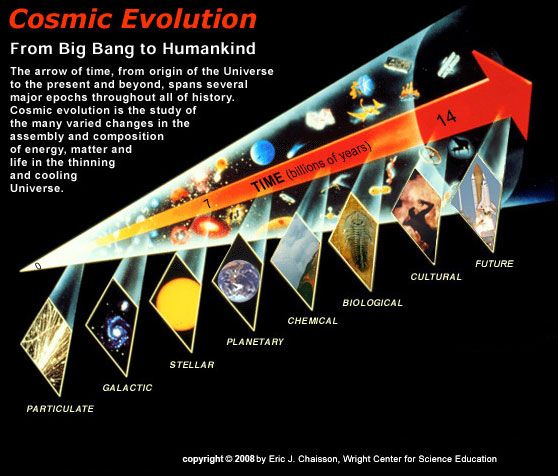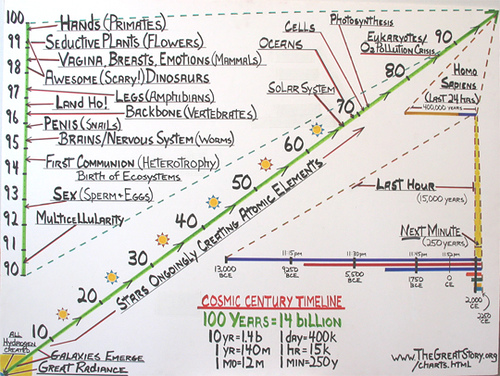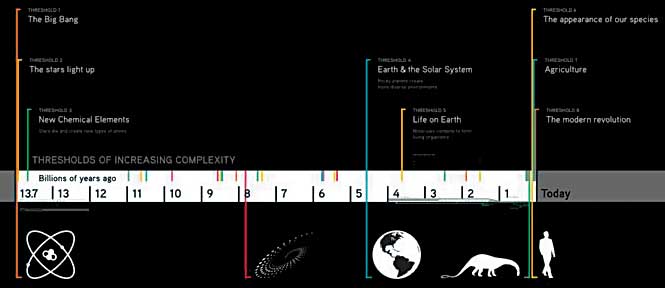
image from Cosmic Evolution home page
| Cosmic Evolution | ||
| Cosmic Evolution | Big History Deep Time |
| PageBack: Emergence | Palaeos | Cosmic Evolution | ||
| Time | Deep Time | Abiotic | Cosmos | Science |

Text adapted from Wikipedia:
A number of scientists, religionists, and popular writers, beginning with eco-theologian Thomas Berry and astro-physicist Brian Swimme in 1992, have been inspired by Teilhard de Chardin to develop a religious perspective on cosmic evolution and complexification, although at the same time rejecting Teilhard's metaphysical and eschatological ideas (Omega Point, Christogenesis, etc) and his excessive anthropocentrism. These authors use terms such as New Story (Thomas Berry, Brian Swimme, Al Gore ), Universal Story (Brian Swimme, John F. Haught), Great Story (Connie Barlow, Michael Dowd), and Everybody's Story (Loyal Rue, yes that's a real name!]),
Husband and wife team Connie Barlow and Michael Dowd's Great Story divides the epic into 8 phases eons or eras: the Great Radiance, the Galactic, Hadean, Archean, Proterozoic, Paleozoic, Mesozoic, and Cenozoic. (Of these, apart from Radiance (= Big Bang) and Galactic (stars and galaxies prior to the formation of the Earth), the rest follow the standard geological timescale) Dowd uses the term 'Epic of Evolution' to help construct his viewpoint of evolution theology (a form of theistic evolution). His position is that science and religious faith are not mutually exclusive. He preaches that the epic of cosmic, biological, and human evolution, revealed by science, is a basis for an inspiring and meaningful view of our place in the universe. Evolution is viewed as a spiritual process that it is not meaningless blind chance (as explained in his book Thank God for Evolution). The position here, in contrast to creationism but in keeping with writers like Stephen Jay Gould, is very much that science and traditional religion (I'm not talking Einsteinian or Teilhardian pantheism) can co-exist, and that religious faith does not mean giving up a naturalistic understanding of the material universe; see also Clergy Letter Project. Note that unlike Hegel and Teilhard, the New Story and Epic of Evolution people are not stating that the cosmos is teleological)
The overall integrative cosmology is very similar to Jantsch, but less concerned with explaining the dynamics of self-emergence, and simpler also in that it does not have the polarity of micro and macro scales. Instead, scientific cosmology becomes the new story of creation, in keeping with naturalist perspectives, to replace the old supernatural model such as the literal account of Genesis.
See also the Great Story timeline
image from Slark's photostream
 image from Cosmic Evolution home page |
Text adapted from Wikipedia:
The term "Epic of Evolution" seems to have been first used by Harvard biologist Edward O. Wilson in 1978. He was using 'myth' as a grand narrative that provides a people with a meaningful placement in time, not as a falsehood, or for that matter as an allegorical and anthropocentric account of creation. It was also used as the title of a book by astrophysicist and science educator Eric Chaisson, the author of Cosmic Evolution: Rise of Complexity in Nature, (Harvard Univ. Press, 2001) and Epic of Evolution: Seven Ages of the Cosmos, (Columbia Univ. Press, 2006). Chaisson's account of Cosmic Evolution is based on evolutionary directionality, and he divides this into 'Seven Ages of the Cosmos': Particulate, Galactic, Stellar, Planetary, Chemical, Biological and Cultural, with evolution continuing into the future. These various stages and hierarchies of evolution (which also occur simultaneously as well as progressively) can be defined as:
Evolution here is the same as with the Great Story authors, only the approach is purely secular, without religious aspects.
Big History: is a new field of academic study that examines history on a large scale across long time frames through a multi-disciplinary approach. It examines history not in the human sense of the written word and past events, but from a cosmological context.
From Wikipedia:
Big history evolved from interdisciplinary studies in the mid-20th century, during the Cold War and Space Race. Some of the first efforts were Cosmic Evolution at Harvard University (USA) and Universal History in the Soviet Union. The first actual courses in what is today called big history were experimental ones taught in the late 1980s by John Mears at Southern Methodist University (Dallas, Texas) and by David Christian at Macquarie University (Australia) and San Diego State University (USA). [doc linkpdf link] Since then, other universities have offered similar courses. An important book in big history was published in 1996 by Fred Spier from the University of Amsterdam that was entitled The Structure of Big History: From the Big Bang until Today, which offers an ambitious defense of the project and constructs a unified account of history across all time scales. One notable text in big history is David Christian's Maps of Time: An Introduction to Big History, which explores the trajectory of history from the first micro-seconds of the Big Bang, to the creation of the solar system, to the origins of life on earth, the evolution of humans, the agricultural revolution, modernity, and the 20th century. In his book and big history course available through The Teaching Company, Christian examines large-scale patterns and themes, and provides perspective of time scales. Fred Spier's new text, Big History and the Future of Humanity, was published by Wiley-Blackwell in 2010. Currently in process is a text book on big history for McGraw Hill by David Christian, Cynthia Stokes Brown and Craig Benjamin. Cynthia Stokes Brown initiated big history at Dominican University of California and wrote Big History: From the Big Bang to the Present. [link] The Dominican University program in big history is part of the university's First Year Experience [link] and is directed by Mojgan Behmand. As of 2011, about 50 professors are offering as many courses in big history around the world. There is a movement underway to make big history the basic course for students in higher education throughout the world.
Also worth mentioning here is Bill Bryson's A Short History of Nearly Everything, and Eric Chaisson's Cosmic Evolution is also on the reading list.
The Big History Project website mentions eight Thresholds of Increasing Complexity, involving the sudden emergence of new qualities that had not existed before. These are more or less equivalent to Jantsch's three stages, Chaisson's Seven Ages, and the seven evolutionary stages I (MAK) mention in my cosmic evolution diagram. They are:
The timeline plots these thresholds against cosmological time, as shown below (image from View the BIG picture - Teacher plus blog):

Big History doesn't actually say anything new, but rather integrates the sum of human knowledge into a single extended timeline which spans many scales from cosmological and geological down to modern history..
Links: Big History org, Big History Project, Chronozoom
Strategic forecaster Theodore Modis, compared lists of key events in cosmic, biological, and human history - among others those of Carl Sagan, biochemist Paul D. Boyer, Encyclopedia Britannica, American Museum of Natural History and University of Arizona, and a 1991 UCLA symposium on "Major Events in the History of Life", and a number of science writers and academics, to develop a mathematical law that governs the evolution of complexity in the Universe, and noticed these all agreed and averaged out
He noticed seven small logistic curves or events superimposed in the main curve (as shown by the flat regions), which he called "Cosmic"; for the process of the formation of the universe and our galaxy; "Geological" for early forms of life and the appearance of multicellular life; "Hominization" for the evolution of Hominidae, the appearance of first bipedalism and stone tools, and ending with the development of speech ; "Homo sapiens", a relatively short period dominated by Homo sapiens and the domestic use of fire; "Modern human" for the period between the first burial of the dead (actually this would include Neanderthal as well, who buried their dead), paleolithic rock art, magic and shamanism, and ending with the invention of agriculture; "Civilization" for the appearance of writing and the wheel, city dwelling and religion; and finally, "Scientific" for the growth phase beginning with the renaissance, centered on the industrial revolution, and the establishment of scientific method, and ending with modern physics. (Modis 2002)
 Sub Processes in the Evolution of Complexity. This is the same curve as shown in the Growth of Complexity diagram. Diagram by Modis 2002 |
Theodore Modis, Forecasting the Growth of Complexity and Change, Technological Forecasting & Social Change, 69, No 4, 2002
| Emergence | Cosmic Evolution |
content by MAK110419. Edited RFVS111024
